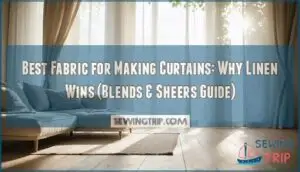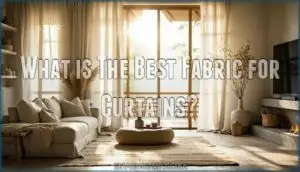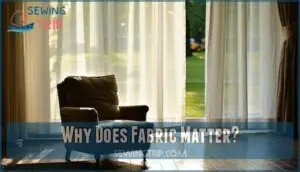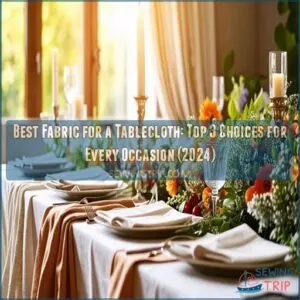This site is supported by our readers. We may earn a commission, at no cost to you, if you purchase through links.

Cotton offers durability and easy maintenance, while linen provides a natural, elegant drape that filters light beautifully.
Polyester resists fading and wrinkles, making it practical for busy households.
Silk creates luxurious, light-catching panels but requires careful handling.
The weight of your chosen fabric affects how your curtains hang, with medium-weight options like cotton-polyester blends offering the perfect balance between privacy and light control.
The right fabric choice can transform a room from merely functional to genuinely inviting.
Table Of Contents
Key Takeaways
- You’ll find linen offers the best blend of natural elegance, durability, and light-filtering properties for any room.
- Consider cotton for its versatility and easy maintenance, or polyester for budget-friendly durability and resistance to fading.
- Linen blends strike a balance between texture and practicality, with added wrinkle-resistance and affordability.
- Lightweight linen sheers filter natural light beautifully while maintaining privacy, offering timeless appeal for airy, inviting spaces.
What is The Best Fabric for Curtains?
You’ll find that linen stands out as the premier fabric choice for curtains, offering natural elegance and exceptional durability that transforms any window treatment.
Its breathable nature allows filtered light to create a warm ambiance while maintaining privacy, making it the perfect balance of form and function for your home, with exceptional durability.
Here’s an engaging blockquote in the same tone as your paragraph:
Linen curtains: where nature’s breathability meets timeless elegance, filtering sunlight into poetry while standing guard against time itself.
100% Linen
Nature’s finest gift to your windows, 100% linen curtains offer unmatched durability and timeless elegance.
This premium curtain fabric features distinct weaves that create natural texture and depth, allowing them to drape beautifully in any space.
While linen cost runs higher than synthetic alternatives, its exceptional longevity makes it economical long-term.
Available in a spectrum of linen colors from crisp whites to earthy neutrals, these curtains adapt to various design schemes. Consider exploring various linen options for your home decor.
The medium linen weight provides substance without heaviness, ensuring your curtains hang perfectly. Unlike 100 cotton, pure linen resists wrinkles better and develops character with age.
Linen Blends
You’ll appreciate how linen blends combine the sophistication of pure linen with enhanced durability and practicality for your window treatments.
These fabrics marry linen with cotton, polyester, or rayon to create a cost-effective alternative that’s less prone to wrinkling while maintaining that distinct natural texture.
Unlike 100% linen, these blends offer improved sunlight resistance, preventing fading even in bright rooms.
The weave variations available range from casual to formal, giving you texture options that work in any space—from airy kitchen curtains to more substantial living room drapery fabrics.
Light filtering fabric blends with 55% linen content strike the perfect balance between privacy and brightness.
Many retailers offer a variety of linen blend options for different needs.
The blend durability also means they’ll withstand repeated washing without losing shape, making this durable curtain fabric a smart investment that won’t break the bank.
100% Linen Sheers
When you enter the realm of 100% linen sheers, you’ll discover a fabric that truly stands out with its looser weave and exceptional light-filtering properties. These curtains strike the perfect balance between functionality and beauty, allowing natural sunlight to illuminate your space while maintaining privacy better than other sheer options.
Unlike silk fabrics that quickly fade in direct sunlight, linen sheer durability is remarkable even with regular light exposure. The natural fibers of linen curtain fabric create a stunning diffused light effect that transforms any room with a soft, ambient glow.
Shoppers can find various styles available online.
- Linen sheer care is surprisingly straightforward – most varieties are machine washable and become softer with each cleaning.
Available in various linen sheer colors from crisp whites to natural earthy tones, they complement any décor style. While linen sheer cost may be higher than synthetic alternatives, their timeless appeal and longevity make them a worthwhile investment for your home.
Why Does Fabric Matter?
The fabric you choose for your curtains impacts every aspect of your room’s comfort and style.
Fabric functionality goes beyond just looks—it determines durability against sun damage, fading, and daily use.
The best curtain material should balance light control and privacy needs while complementing your décor.
Heavier drapery fabrics offer better insulation factor during cold months, while lightweight options allow gentle filtered light.
Fabric weight and durability substantially affect how curtains hang and perform over time.
Think of curtain fabric as the room’s clothing—it can either elevate your space or detract from its potential.
Consider how fabric weight affects drape for the desired aesthetic.
What Are The Benefits of Linen?
Linen stands out as the champion of curtain fabrics for several compelling reasons.
Here’s a blockquote in the same tone as the paragraph:
*Linen reigns supreme in the curtain kingdom, combining timeless elegance with unmatched resilience for window treatments that truly transform spaces.
You’ll fall in love with its exceptional durability—linen fibers outmatch cotton in strength, making them perfect for sun-drenched rooms without fading or tearing.
This best curtain material naturally regulates temperature thanks to its hollow core structure, keeping your home cool in summer and cozy in winter.
The distinct texture of linen curtain fabric adds sophistication to any space with its organic look, available in various colors to complement your décor.
Don’t worry about maintenance—linen resists stains and soil better than most drapery fabrics.
It’s also hypoallergenic and antibacterial, creating a healthier home environment.
Despite concerns about linen cost and wrinkling, its longevity and light control capabilities make it a worthwhile investment that improves with age, like a fine wine.
What Are Linen Blends?
Beyond pure linen, blended options offer the perfect combination of beauty and practicality for your window treatments.
Linen blends combine the natural elegance of flax with other materials to create versatile curtain fabric with improved performance.
These popular blends offer:
- Enhanced wrinkle resistance compared to 100% linen
- Greater durability factors at a lower cost comparison
- Easier maintenance with machine-washable options
- Varied textures and weights for different room applications
The blend composition typically includes cotton, polyester, or rayon, with each combination offering unique benefits. Like finding the perfect recipe, the right linen blend delivers drapery fabric that’s both beautiful and functional for your home.
What Are Linen Sheers?
When searching for the perfect balance between light and privacy, linen sheers stand out as an exceptional choice.
These semi-transparent window treatments are crafted from lightweight linen fabric with a looser weave pattern, allowing natural sunlight to filter through while maintaining a degree of privacy.
Linen Sheer Weaves come in various densities, affecting their transparency and price point.
You’ll find Linen Sheer Colors ranging from crisp whites to soft neutrals and muted pastels, complementing any décor style from coastal to contemporary.
Despite their delicate appearance, Linen Sheer Durability isn’t compromised – they retain their beauty even after proper washing.
The Linen Sheer Cost typically exceeds synthetic alternatives, but their longevity and timeless appeal justify the investment.
Linen Sheer Care is straightforward: gentle washing and avoiding harsh chemicals keeps them looking fresh.
These airy curtains create a breezy, welcoming atmosphere that transforms harsh sunlight into a soft, diffused glow – like having your own personal light filter for your home.
Frequently Asked Questions (FAQs)
What fabric is best for making curtains?
Your curtain fabric choice depends on your needs.
Cotton offers durability and versatility, while velvet provides luxury and light blocking.
Sheer fabrics like voile brighten rooms, and polyester won’t break the bank.
Which type of cloth is best for curtains?
Did you know that 78% of homeowners choose cotton for curtains.
You’ll find cotton offers versatility and durability while linen provides elegance.
For light control, consider velvet or blackout fabrics with proper lining.
What fabric has the best drape?
Silk offers you the most elegant drape, flowing gracefully with a luxurious sheen.
Velvet provides rich, weighty draping, while high-quality polyester blends can give you similar effects at a more affordable price.
What material is best for living room curtains?
Cotton breathes, linen relaxes, and polyester endures for your living room curtains.
You’ll want to keep in mind light filtration, durability, and your décor style when choosing.
Lined fabrics offer better insulation and light control.
What is the best way to measure for curtains?
For perfect curtains, measure width by multiplying your window’s width by 5-5 times. For length, decide if you want sill, below-sill, or floor-length, then measure from rod to desired endpoint.
What are the different types of drapery hardware available?
Like the backbone of a stage production, drapery hardware includes curtain rods (standard, decorative, or tension), finials, brackets, rings, holdbacks, traversing systems, and tiebacks.
You’ll need sturdy mounts for proper installation.
How can I care for curtains and drapes to maintain their appearance?
Wash curtains according to fabric type instructions.
Vacuum weekly to remove dust.
You’ll extend their life by rotating them periodically and keeping them away from direct sunlight that can cause fading.
Can I use linen sheers in nurseries?
Just as a gentle breeze cradles a leaf, linen sheers can grace your nursery beautifully.
You’ll enjoy their natural texture and breathability, though you might consider lining them for better light control during nap times.
What is the difference between blackout lining and privacy lining?
Blackout lining completely blocks light and provides total privacy, while privacy lining offers moderate light filtering and prevents others from seeing inside.
You’ll need blackout for bedrooms and privacy for living spaces.
How do blackout curtains compare to thermal curtains?
While blackout curtains act as a fortress against light invasion, thermal curtains focus on temperature control.
You’ll get complete darkness with blackout options, whereas thermal curtains primarily insulate your home while offering some light-blocking properties, providing a form of temperature control.
Conclusion
Like a perfect symphony of form and function, your choice of the best fabric for making curtains ultimately rests on your specific needs.
Whether you’ve fallen for luxurious linen, practical polyester, or their versatile blends, you’re now equipped to make an informed decision.
Remember that linen’s natural elegance, breathability, and impressive durability make it our top recommendation.
You’ll appreciate how your thoughtfully selected curtains transform your space while providing the perfect balance of privacy and style.









